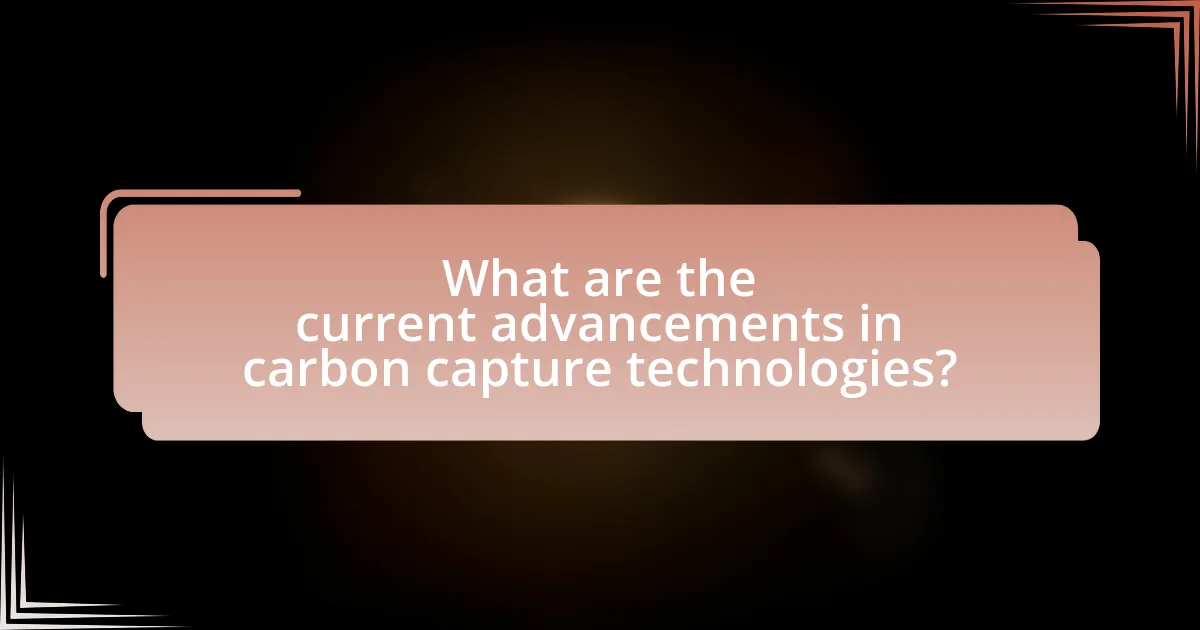Innovative carbon capture technologies are advanced methods aimed at capturing carbon dioxide emissions from industrial processes and power generation, including direct air capture and carbon capture and storage (CCS). These technologies utilize various processes such as absorption, adsorption, and membrane separation to significantly reduce CO2 emissions, with CCS projected to contribute to a 14% reduction in global emissions by 2050. The article reviews the functioning, efficiency comparisons, and importance of carbon capture in climate change mitigation, highlighting recent advancements and breakthroughs in the field, as well as the challenges and future prospects for widespread adoption. Key factors influencing the effectiveness and implementation of these technologies are also discussed, providing a comprehensive overview of their role in achieving net-zero emissions.

What are Innovative Carbon Capture Technologies?
Innovative carbon capture technologies are advanced methods designed to capture carbon dioxide emissions from various sources, particularly industrial processes and power generation. These technologies include direct air capture, which uses chemical processes to extract CO2 directly from the atmosphere, and carbon capture and storage (CCS), which involves capturing CO2 emissions at their source and storing them underground in geological formations. According to the International Energy Agency, CCS could contribute to reducing global CO2 emissions by up to 14% by 2050, highlighting its potential impact on climate change mitigation.
How do these technologies function in reducing carbon emissions?
Innovative carbon capture technologies function by capturing carbon dioxide emissions from sources like power plants and industrial processes before they enter the atmosphere. These technologies utilize various methods, such as chemical absorption, where CO2 is absorbed by solvents, and physical adsorption, where CO2 adheres to solid materials. For instance, the use of amine-based solvents can capture up to 90% of CO2 emissions from flue gases, significantly reducing the overall carbon footprint of fossil fuel energy production. Additionally, advancements in direct air capture technologies allow for the extraction of CO2 directly from the ambient air, further contributing to emission reductions.
What are the key processes involved in carbon capture?
The key processes involved in carbon capture include absorption, adsorption, membrane separation, and cryogenic separation. Absorption typically utilizes solvents, such as amines, to chemically react with carbon dioxide, effectively removing it from gas streams. Adsorption relies on solid materials that capture CO2 on their surface, often using materials like zeolites or activated carbon. Membrane separation employs selective barriers that allow CO2 to pass through while retaining other gases, enhancing efficiency in separation. Cryogenic separation involves cooling gas mixtures to very low temperatures, causing CO2 to liquefy and separate from other gases. These processes are essential for reducing greenhouse gas emissions and are integral to various carbon capture technologies currently being developed and implemented.
How do different technologies compare in efficiency?
Different carbon capture technologies exhibit varying levels of efficiency, with some methods capturing over 90% of CO2 emissions while others achieve lower rates. For instance, post-combustion capture technologies, such as amine scrubbing, can achieve efficiencies around 85-90%, while newer technologies like direct air capture can reach similar efficiencies but often at a higher energy cost. Research indicates that integrated systems combining multiple technologies can enhance overall efficiency, as demonstrated in studies where hybrid approaches improved CO2 capture rates by up to 15%.
Why is carbon capture important for climate change mitigation?
Carbon capture is crucial for climate change mitigation because it directly reduces the amount of carbon dioxide released into the atmosphere from industrial processes and energy production. By capturing CO2 emissions before they enter the atmosphere, carbon capture technologies can significantly lower greenhouse gas concentrations, which are responsible for global warming. According to the Intergovernmental Panel on Climate Change (IPCC), achieving net-zero emissions by 2050 will require the deployment of carbon capture and storage (CCS) technologies to remove approximately 1.7 billion tons of CO2 annually. This demonstrates that carbon capture is not only a viable solution but also an essential component of comprehensive climate strategies aimed at limiting temperature rise to 1.5 degrees Celsius.
What role does carbon capture play in achieving net-zero emissions?
Carbon capture plays a critical role in achieving net-zero emissions by removing carbon dioxide from the atmosphere and preventing it from entering the environment. This technology enables industries, particularly those that are hard to decarbonize, to continue operations while significantly reducing their carbon footprint. For instance, the International Energy Agency (IEA) reports that carbon capture, utilization, and storage (CCUS) could contribute to around 15% of the global emissions reductions needed by 2050 to meet climate targets. By capturing CO2 emissions from sources like power plants and industrial processes, carbon capture technologies facilitate the transition to a sustainable energy system and help mitigate climate change impacts.
How does carbon capture impact global warming potential?
Carbon capture significantly reduces global warming potential by preventing carbon dioxide emissions from entering the atmosphere. This technology captures CO2 produced from industrial processes and energy generation, thereby mitigating the greenhouse effect that contributes to climate change. For instance, the Global CCS Institute reports that carbon capture and storage (CCS) can reduce emissions by up to 90% in certain applications, directly impacting the overall concentration of greenhouse gases. By lowering atmospheric CO2 levels, carbon capture plays a crucial role in achieving climate targets set by international agreements, such as the Paris Agreement, which aims to limit global temperature rise.

What are the current advancements in carbon capture technologies?
Current advancements in carbon capture technologies include the development of direct air capture systems, enhanced mineralization processes, and the integration of carbon capture with renewable energy sources. Direct air capture technologies, such as those developed by companies like Climeworks, utilize chemical processes to extract CO2 directly from the atmosphere, achieving efficiencies that can capture thousands of tons of CO2 annually. Enhanced mineralization processes, which involve the reaction of CO2 with naturally occurring minerals to form stable carbonates, have seen significant improvements in reaction rates and scalability, as demonstrated by research from the University of California, Berkeley. Additionally, integrating carbon capture with renewable energy sources, such as solar and wind, allows for more sustainable and cost-effective operations, as evidenced by projects like the Carbon Clean Solutions’ partnership with various industrial sectors to reduce emissions while generating energy. These advancements collectively contribute to the growing effectiveness and viability of carbon capture technologies in mitigating climate change.
What are the latest innovations in direct air capture?
The latest innovations in direct air capture include advancements in sorbent materials, modular systems, and integration with renewable energy sources. Recent developments have focused on using metal-organic frameworks (MOFs) and advanced amine-based sorbents that enhance CO2 capture efficiency and reduce energy consumption. For instance, a study published in Nature Communications in 2023 demonstrated that new MOF designs can capture CO2 at lower temperatures, significantly improving the energy efficiency of the process. Additionally, companies like Climeworks and Carbon Engineering are deploying modular direct air capture units that can be scaled up rapidly, allowing for more flexible and cost-effective installations. These innovations are crucial for meeting global climate targets by enabling large-scale CO2 removal from the atmosphere.
How do these innovations improve capture rates?
Innovations in carbon capture technologies improve capture rates by enhancing the efficiency and effectiveness of CO2 absorption processes. For instance, advancements in materials such as metal-organic frameworks (MOFs) and amine-based solvents have demonstrated significantly higher adsorption capacities compared to traditional methods, achieving capture rates exceeding 90% in some applications. Additionally, the integration of machine learning algorithms for optimizing operational parameters has led to real-time adjustments that maximize capture efficiency, further increasing overall performance. These innovations collectively contribute to more effective carbon capture, as evidenced by pilot projects that report substantial reductions in emissions.
What are the cost implications of these advancements?
The cost implications of advancements in innovative carbon capture technologies include significant initial investment and operational costs, which can range from $50 to $100 per ton of CO2 captured. These costs are influenced by factors such as technology type, scale of implementation, and energy requirements. For instance, a study by the International Energy Agency (IEA) indicates that while the costs of carbon capture have decreased by approximately 30% over the past decade due to technological improvements, the economic viability still heavily relies on government incentives and carbon pricing mechanisms. Additionally, the long-term savings from reduced carbon emissions and potential revenue from carbon credits can offset these initial costs, making the overall financial impact more favorable in the context of climate change mitigation.
What breakthroughs have been made in industrial carbon capture?
Recent breakthroughs in industrial carbon capture include the development of advanced materials and processes that significantly enhance CO2 absorption efficiency. For instance, the use of metal-organic frameworks (MOFs) has shown promise, with some MOFs achieving CO2 capture capacities exceeding 200 mg CO2 per gram of material. Additionally, direct air capture technologies have advanced, with companies like Climeworks successfully deploying systems that can capture thousands of tons of CO2 annually. Furthermore, innovations in solvent-based capture methods, such as the use of amine scrubbing, have improved the energy efficiency of carbon capture processes, reducing the overall cost of implementation. These advancements are supported by ongoing research and pilot projects that demonstrate the scalability and effectiveness of these technologies in real-world industrial applications.
How are these breakthroughs being implemented in various industries?
Breakthroughs in innovative carbon capture technologies are being implemented across various industries to reduce greenhouse gas emissions. For instance, the energy sector is adopting direct air capture systems, such as those developed by Climeworks, which can remove CO2 directly from the atmosphere and store it underground or utilize it in products. In the cement industry, companies like Carbon Clean Solutions are integrating carbon capture technologies into their processes, capturing up to 90% of CO2 emissions during production. The chemical industry is also utilizing carbon capture by converting captured CO2 into useful chemicals, as demonstrated by companies like LanzaTech, which transforms CO2 into ethanol. These implementations are supported by research indicating that carbon capture can significantly mitigate climate change impacts, with studies showing potential reductions of up to 1.5 gigatons of CO2 emissions annually if widely adopted.
What challenges do industries face in adopting these technologies?
Industries face significant challenges in adopting innovative carbon capture technologies, primarily due to high costs, technological complexity, and regulatory uncertainties. The initial investment required for implementing these technologies can be substantial, often deterring companies from making the transition. For instance, a study by the International Energy Agency indicates that the cost of capturing carbon can range from $50 to $100 per ton, which can be prohibitive for many industries. Additionally, the technological complexity involved in integrating carbon capture systems with existing infrastructure poses operational challenges, requiring specialized knowledge and training. Furthermore, regulatory uncertainties can hinder investment decisions, as industries may be unsure about future policies and incentives related to carbon emissions. These factors collectively create a challenging environment for the widespread adoption of carbon capture technologies.

What are the future prospects for carbon capture technologies?
The future prospects for carbon capture technologies are promising, with advancements expected to significantly enhance efficiency and reduce costs. Research indicates that innovations such as direct air capture and bioenergy with carbon capture and storage (BECCS) are gaining traction, potentially capturing billions of tons of CO2 annually by 2050. The International Energy Agency (IEA) projects that carbon capture could contribute to 15% of the necessary emissions reductions to meet global climate goals. Additionally, investments in carbon capture technologies are increasing, with funding from both public and private sectors aimed at scaling up deployment and improving technology readiness.
How might emerging technologies shape the future of carbon capture?
Emerging technologies are poised to significantly enhance the efficiency and effectiveness of carbon capture by introducing advanced materials, innovative processes, and automation. For instance, the development of metal-organic frameworks (MOFs) has shown promise in capturing carbon dioxide with high selectivity and capacity, as evidenced by research from the University of California, Berkeley, which demonstrated that MOFs can outperform traditional sorbents in specific applications. Additionally, advancements in direct air capture (DAC) technologies, such as those being developed by companies like Climeworks, utilize renewable energy sources to power the capture process, making it more sustainable. Furthermore, machine learning and artificial intelligence are being integrated into carbon capture systems to optimize operations and predict maintenance needs, thereby increasing overall efficiency. These technological innovations collectively indicate a transformative shift in carbon capture capabilities, aligning with global climate goals.
What role will artificial intelligence play in optimizing carbon capture?
Artificial intelligence will play a crucial role in optimizing carbon capture by enhancing the efficiency and effectiveness of capture technologies. AI algorithms can analyze vast datasets to identify optimal conditions for carbon capture processes, predict equipment performance, and improve the design of capture systems. For instance, machine learning models can optimize the operation of carbon capture plants by adjusting parameters in real-time based on environmental conditions and operational data, leading to increased capture rates and reduced energy consumption. Studies have shown that AI-driven optimization can lead to a 20-30% increase in carbon capture efficiency, demonstrating its significant impact on advancing carbon capture technologies.
How can policy changes influence the development of these technologies?
Policy changes can significantly influence the development of innovative carbon capture technologies by establishing regulatory frameworks, providing funding incentives, and promoting research and development initiatives. For instance, the implementation of carbon pricing mechanisms, such as cap-and-trade systems or carbon taxes, can create economic incentives for companies to invest in carbon capture solutions. According to a report by the International Energy Agency, countries that have adopted such policies have seen increased investments in carbon capture technologies, leading to advancements in efficiency and cost-effectiveness. Furthermore, government funding for research and development can accelerate technological breakthroughs, as evidenced by the U.S. Department of Energy’s investment in carbon capture projects, which has resulted in significant progress in the field.
What are the best practices for implementing carbon capture solutions?
The best practices for implementing carbon capture solutions include selecting appropriate technologies based on specific emission sources, ensuring integration with existing industrial processes, and conducting thorough feasibility studies. For instance, technologies such as amine-based absorption and membrane separation have proven effective in various settings, as evidenced by their deployment in large-scale facilities like the Petra Nova project in Texas, which captures over 1.6 million tons of CO2 annually. Additionally, continuous monitoring and optimization of the capture process are essential to enhance efficiency and reduce costs, as demonstrated by research from the International Energy Agency, which highlights the importance of operational data in improving carbon capture performance.
What factors should organizations consider when choosing a technology?
Organizations should consider the technology’s effectiveness in carbon capture, cost, scalability, compatibility with existing systems, and regulatory compliance. Effectiveness is crucial as it determines the technology’s ability to reduce greenhouse gas emissions significantly; for instance, technologies like direct air capture can achieve up to 90% CO2 removal efficiency. Cost considerations include both initial investment and long-term operational expenses, with some carbon capture technologies costing between $50 to $100 per ton of CO2 captured. Scalability is essential for widespread adoption, as technologies must be adaptable to various industrial applications. Compatibility with existing systems ensures seamless integration, which can enhance operational efficiency. Lastly, regulatory compliance is vital, as organizations must adhere to environmental regulations that govern emissions, influencing technology selection.
How can companies measure the effectiveness of their carbon capture efforts?
Companies can measure the effectiveness of their carbon capture efforts by quantifying the amount of carbon dioxide captured and comparing it to the total emissions produced. This can be achieved through direct measurement techniques such as gas flow meters and chemical analysis, which provide precise data on the volume of CO2 captured. For instance, the Global CCS Institute reported that successful carbon capture projects have achieved capture rates exceeding 90%, demonstrating the potential effectiveness of these technologies. Additionally, companies can utilize lifecycle assessments to evaluate the overall impact of their carbon capture systems, including energy consumption and cost-effectiveness, thereby providing a comprehensive view of their performance in reducing greenhouse gas emissions.


